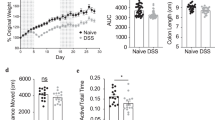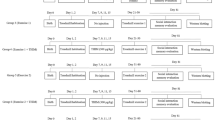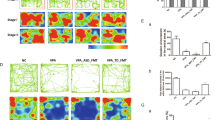Abstract
Autism spectrum disorder (ASD) is a neurodevelopmental disorder characterized by social disorder and stereotypical behavior, and its incidence rate is increasing yearly. It is considered that acritical period for the prognosis of young children with ASD exists, thus early treatment is crucial. Swimming, due to its comforting effect, is often used to induce enthusiasm in young children for completing activities and has a good effect in the treatment of ASD, but the effective path of swimming has yet to be reported. The intestinal microbiota of ASD patients and animal models has been reported to be different from that of healthy controls, and these changes may affect the brain environment. Therefore, whether the intestinal microbiota is involved in the treatment of ASD by early swimming is our concern. In this study, we used 8-day old Shank3 gene knockout rats with 8 weeks of early load swimming training and conducted behavioral, small intestine morphology, and intestinal content sequencing after training. The results showed that early load swimming significantly reduced the stereotyped and anxious behaviors of Shank3-/- rats, increased their muscle strength, increased the length of intestinal villi and the width of the muscular layer after Shank3 knockout, and affected the abundance of intestinal microorganisms. The abundances with statistical significance were Lactobacillus, Lachnospiraceae, and Alloprevotella. To further confirm the role of intestinal microorganisms in it, we designed a 14-day intestinal stool transplantation experiment. Fecal microbiota transplantation demonstrated that load swimming can significantly reduce the anxiety behavior of Shank3 rats, increase their muscle strength, change the structure of the small intestine, and affect the abundance of intestinal contents. The abundance of Epsilonbateraeota, Prevotella, and Bacteroides significantly changed after transplantation. Our findings confirm the possibility of early load swimming therapy for individuals with ASD and explain that the intestinal microbiota is a key pathway for early exercise therapy for patients with ASD.






Similar content being viewed by others
Data Availability
The data that support the findings of this study are available from the corresponding author upon reasonable request.
References
Sturman DA, Moghaddam B (2011) The neurobiology of adolescence: changes in brain architecture, functional dynamics, and behavioral tendencies. Neurosci Biobehav Rev 35(8):1704–1712
Burnett S et al (2011) The social brain in adolescence: evidence from functional magnetic resonance imaging and behavioural studies. Neurosci Biobehav Rev 35(8):1654–1664
Caspi A, Houts RM, Ambler A, Danese A, Elliott ML, Hariri A, Harrington H, Hogan S, Poulton R, Ramrakha S, Rasmussen LJH, Reuben A, Richmond Rakerd L, Sugden K, Wertz J, Williams BS, Moffitt TE (2020) Longitudinal assessment of mental health disorders and comorbidities across 4 decades among participants in the Dunedin birth cohort study. JAMA Netw Open 3(4):e203221. https://doi.org/10.1001/jamanetworkopen.2020.3221
Whitehouse AJO, Varcin KJ, Pillar S, Billingham W, Alvares GA, Barbaro J, Bent CA, Blenkley D, Boutrus M, Chee A, Chetcuti L, Clark A, Davidson E, Dimov S, Dissanayake C, Doyle J, Grant M, Green CC, Harrap M, Iacono T, Matys L, Maybery M, Pope DF, Renton M, Rowbottam C, Sadka N, Segal L, Slonims V, Smith J, Taylor C, Wakeling S, Wan MW, Wray J, Cooper MN, Green J, Hudry K (2021) Effect of preemptive intervention on developmental outcomes among infants showing early signs of autism: a randomized clinical trial of outcomes to diagnosis. JAMA Pediatr 175(11):e213298. https://doi.org/10.1001/jamapediatrics.2021.3298
Chang L, Wei Y, Hashimoto K (2022) Brain-gut-microbiota axis in depression: a historical overview and future directions. Brain Res Bull 182:44–56
Kayama H, Okumura R, Takeda K (2020) Interaction between the microbiota, epithelia, and immune cells in the intestine. Annu Rev Immunol 38(38):23–48
Liu Y et al (2021) Gut microbiome alterations in high-fat-diet-fed mice are associated with antibiotic tolerance. Nat Microbiol 6(7):874–884
Clarke G et al (2013) The microbiome-gut-brain axis during early life regulates the hippocampal serotonergic system in a sex-dependent manner. Mol Psychiatry 18(6):666–673
Morais LH, Schreiber HLT, Mazmanian SK (2021) The gut microbiota-brain axis in behaviour and brain disorders. Nat Rev Microbiol 19(4):241–255
Desbonnet L et al (2014) Microbiota is essential for social development in the mouse. Mol Psychiatry 19(2):146–148
Gareau MG et al (2011) Bacterial infection causes stress-induced memory dysfunction in mice. Gut 60(3):307–317
Kennedy PJ et al (2014) Irritable bowel syndrome: a microbiome-gut-brain axis disorder? World J Gastroenterol 20(39):14105–14125
Finegold SM et al (2010) Pyrosequencing study of fecal microflora of autistic and control children. Anaerobe 16(4):444–453
Mayer EA, Padua D, Tillisch K (2014) Altered brain-gut axis in autism: comorbidity or causative mechanisms? Bioessays 36(10):933–939
Smits LP et al (2013) Therapeutic potential of fecal microbiota transplantation. Gastroenterology 145(5):946–953
Borody T et al (2012) Bacteriotherapy in chronic fatigue syndrome (CFS): a retrospective review. Am J Gastroenterol 107:S591–S592
Coretti L et al (2018) Gut microbiota features in young children with autism spectrum disorders. Front Microbiol 9:3146
Kim S et al (2017) Maternal gut bacteria promote neurodevelopmental abnormalities in mouse offspring. Nature 549(7673):528–532
Sharon G et al (2019) Human gut microbiota from autism spectrum disorder promote behavioral symptoms in mice. Cell 177(6):1600–1618 e17
Srinivasan SM, Pescatello LS, Bhat AN (2014) Current perspectives on physical activity and exercise recommendations for children and adolescents with autism spectrum disorders. Phys Ther 94(6):875–889
Koutouratsas T et al (2021) Role of exercise in preventing and restoring gut dysbiosis in patients with inflammatory bowel diseases: a review. World J Gastroenterol 27(30):5037–5046
Mika A, Fleshner M (2016) Early-life exercise may promote lasting brain and metabolic health through gut bacterial metabolites. Immunol Cell Biol 94(2):151–157
Rizzoli R, Biver E, Brennan-Speranza TC (2021) Nutritional intake and bone health. Lancet Diabetes Endocrinol 9(9):606–621
Hutchinson KJ et al (2004) Three exercise paradigms differentially improve sensory recovery after spinal cord contusion in rats. Brain 127(Pt 6):1403–1414
Naisbitt S et al (1999) Shank, a novel family of postsynaptic density proteins that binds to the NMDA receptor/PSD-95/GKAP complex and cortactin. Neuron 23(3):569–582
Bozdagi O, Sakurai T, Papapetrou D, Wang X, Dickstein DL, Takahashi N, Kajiwara Y, Yang M, Katz AM, Scattoni ML, Harris MJ, Saxena R, Silverman JL, Crawley JN, Zhou Q, Hof PR, Buxbaum JD (2010) Haploinsufficiency of the autism associated Shank3 gene leads to deficits in synaptic function, social interaction, and social communication. Mol Autism 1(1):1–15. https://doi.org/10.1186/2040-2392-1-15
Yang M et al (2012) Reduced excitatory neurotransmission and mild autism-relevant phenotypes in adolescent Shank3 null mutant mice. J Neurosci 32(19):6525–6541
Duffney LJ et al (2015) Autism-like deficits in Shank3-deficient mice are rescued by targeting actin regulators. Cell Rep 11(9):1400–1413
Wang X, Bey AL, Katz BM, Badea A, Kim N, David LK, Duffney LJ, Kumar S, Mague SD, Hulbert SW, Dutta N, Hayrapetyan V, Yu C, Gaidis E, Zhao S, Ding JD, Xu Q, Chung L, Rodriguiz RM, Wang F, Weinberg RJ, Wetsel WC, Dzirasa K, Yin H, Jiang YH (2016) Altered mGluR5-Homer scaffolds and corticostriatal connectivity in a Shank3 complete knockout model of autism. Nat Commun 7:11459. https://doi.org/10.1038/ncomms11459
Lee J, Chung C, Ha S, Lee D, Kim DY, Kim H, Kim E (2015) Shank3-mutant mice lacking exon 9 show altered excitation/inhibition balance, enhanced rearing, and spatial memory deficit. Front Cell Neurosci 9:94. https://doi.org/10.3389/fncel.2015.00094
Marshall CR et al (2008) Structural variation of chromosomes in autism spectrum disorder. Am J Hum Genet 82(2):477–488
Sato D et al (2012) SHANK1 deletions in males with autism spectrum disorder. Am J Hum Genet 90(5):879–887
Berkel S et al (2010) Mutations in the SHANK2 synaptic scaffolding gene in autism spectrum disorder and mental retardation. Nat Genet 42(6):489–491
Durand CM et al (2007) Mutations in the gene encoding the synaptic scaffolding protein SHANK3 are associated with autism spectrum disorders. Nat Genet 39(1):25–27
Berkel S et al (2012) Inherited and de novo SHANK2 variants associated with autism spectrum disorder impair neuronal morphogenesis and physiology. Hum Mol Genet 21(2):344–357
Pinto D et al (2010) Functional impact of global rare copy number variation in autism spectrum disorders. Nature 466(7304):368–372
Gauthier J et al (2010) De novo mutations in the gene encoding the synaptic scaffolding protein SHANK3 in patients ascertained for schizophrenia. Proc Natl Acad Sci U S A 107(17):7863–7868
Griffiths JA, Mazmanian SK (2018) Emerging evidence linking the gut microbiome to neurologic disorders. Genome Med 10(1):98
Tabouy L et al (2018) Dysbiosis of microbiome and probiotic treatment in a genetic model of autism spectrum disorders. Brain Behav Immun 73:310–319
Sauer AK, Bockmann J, Steinestel K, Boeckers TM, Grabrucker AM (2019) Altered intestinal morphology and microbiota composition in the autism spectrum disorders associated SHANK3 Mouse Model. Int J Mol Sci 20(9):2134. https://doi.org/10.3390/ijms20092134
Harony-Nicolas H, Kay M, du Hoffmann J, Klein ME, Bozdagi-Gunal O, Riad M, Daskalakis NP, Sonar S, Castillo PE, Hof PR, Shapiro ML, Baxter MG, Wagn er S, Buxbaum JD (2017) Oxytocin improves behavioral and electrophysiological deficits in a novel Shank3-deficient rat. Elife 6:e18904. https://doi.org/10.7554/eLife.18904
Song TJ et al (2019) Altered behaviors and impaired synaptic function in a novel rat model with a complete Shank3 deletion. Front Cell Neurosci 13:111
Meng Y et al (2022) Effect of early swimming on the behavior and striatal transcriptome of the Shank3 knockout rat model of autism. Neuropsychiatr Dis Treat 18:681–694
Kelly JR et al (2016) Transferring the blues: depression-associated gut microbiota induces neurobehavioural changes in the rat. J Psychiatr Res 82:109–118
De Angelis M et al (2015) Autism spectrum disorders and intestinal microbiota. Gut Microbes 6(3):207–213
Kang DW et al (2019) Long-term benefit of microbiota transfer therapy on autism symptoms and gut microbiota. Sci Rep 9(1):5821
Kang DW et al (2017) Microbiota Transfer Therapy alters gut ecosystem and improves gastrointestinal and autism symptoms: an open-label study. Microbiome 5(1):10
Li N et al (2021) Fecal microbiota transplantation relieves gastrointestinal and autism symptoms by improving the gut microbiota in an open-label study. Front Cell Infect Microbiol 11:759435
Tan Q et al (2021) Probiotics, prebiotics, synbiotics, and fecal microbiota transplantation in the treatment of behavioral symptoms of autism spectrum disorder: a systematic review. Autism Res 14(9):1820–1836
Iglesias-Vázquez L, Van Ginkel Riba G, Arija V, Canals J (2020) Composition of gut microbiota in children with autism spectrum disorder: a systematic review and meta-analysis. Nutrients 12(3):792. https://doi.org/10.3390/nu12030792
Lau NM et al (2013) Markers of celiac disease and gluten sensitivity in children with autism. PLoS One 8(6):e66155
Nikolov RN et al (2009) Gastrointestinal symptoms in a sample of children with pervasive developmental disorders. J Autism Dev Disord 39(3):405–413
Mandy W et al (2012) Sex differences in autism spectrum disorder: evidence from a large sample of children and adolescents. J Autism Dev Disord 42(7):1304–1313
Robinson EB et al (2013) Examining and interpreting the female protective effect against autistic behavior. Proc Natl Acad Sci U S A 110(13):5258–5262
Kidron R, Kaganovskiy L, Baron-Cohen S (2018) Empathizing-systemizing cognitive styles: effects of sex and academic degree. PLoS One 13(3):e0194515
Wegierska AE et al (2022) The connection between physical exercise and gut microbiota: implications for competitive sports athletes. Sports Med 52(10):2355–2369
Jandhyala SM et al (2015) Role of the normal gut microbiota. World J Gastroenterol 21(29):8787–8803
Zhang Q et al (2021) Comparison of gut microbiota between adults with autism spectrum disorder and obese adults. PeerJ 9:e10946
Ley RE et al (2006) Microbial ecology: human gut microbes associated with obesity. Nature 444(7122):1022–1023
Lange K et al (2016) Effects of antibiotics on gut microbiota. Dig Dis 34(3):260–268
Begum M, Hossain MY, Wahab MA, Ahmed ZF, Alam MJ, Shah MM, Jasmine S (2007) Effects of iso-nutrient fertilization on plankton production in earthen ponds of Bangladesh. Pak J Biol Sci 10(8):1221–8. https://doi.org/10.3923/pjbs.2007.1221.1228
Diao J et al (2021) Silicon dioxide nanoparticles induced neurobehavioral impairments by disrupting microbiota-gut-brain axis. J Nanobiotechnology 19(1):174
Wang S et al (2022) Assess the diversity of gut microbiota among healthy adults for forensic application. Microb Cell Factories 21(1):46
Binda C et al (2018) Actinobacteria: a relevant minority for the maintenance of gut homeostasis. Dig Liver Dis 50(5):421–428
Nahum A, Filice G, Malhotra A (2017) A complicated thread: abdominal actinomycosis in a young woman with Crohn disease. Case Rep Gastroenterol 11(2):377–381
Arnold CE et al (2021) The effects of signalment, diet, geographic location, season, and colitis associated with antimicrobial use or Salmonella infection on the fecal microbiome of horses. J Vet Intern Med 35(5):2437–2448
Hao H et al (2021) Effect of extracellular vesicles derived from lactobacillus plantarum Q7 on gut microbiota and ulcerative colitis in mice. Front Immunol 12:777147
Vacca M, Celano G, Calabrese FM, Portincasa P, Gobbetti M, De Angelis M (2020) The controversial role of human Gut Lachnospiraceae. Microorganisms 8(4):573. https://doi.org/10.3390/microorganisms8040573
Kang DW et al (2018) Differences in fecal microbial metabolites and microbiota of children with autism spectrum disorders. Anaerobe 49:121–131
Oliphant K et al (2021) Bacteroidota and Lachnospiraceae integration into the gut microbiome at key time points in early life are linked to infant neurodevelopment. Gut Microbes 13(1):1997560
Whisner CM et al (2018) Diet, physical activity and screen time but not body mass index are associated with the gut microbiome of a diverse cohort of college students living in university housing: a cross-sectional study. BMC Microbiol 18(1):210
Zhang L et al (2019) The oral microbiota may have influence on oral cancer. Front Cell Infect Microbiol 9:476
Wang CS et al (2018) VSL#3 can prevent ulcerative colitis-associated carcinogenesis in mice. World J Gastroenterol 24(37):4254–4262
Dan Z et al (2020) Altered gut microbial profile is associated with abnormal metabolism activity of autism spectrum disorder. Gut Microbes 11(5):1246–1267
Haran JP et al (2018) The nursing home elder microbiome stability and associations with age, frailty, nutrition and physical location. J Med Microbiol 67(1):40–51
Vernocchi P et al (2022) Gut microbiota ecology and inferred functions in children with ASD compared to neurotypical subjects. Front Microbiol 13:871086
Bojović K et al (2020) Gut microbiota dysbiosis associated with altered production of short chain fatty acids in children with neurodevelopmental disorders. Front Cell Infect Microbiol 10:223
Grant CV et al (2021) Manipulations of the gut microbiome alter chemotherapy-induced inflammation and behavioral side effects in female mice. Brain Behav Immun 95:401–412
de la Cuesta-Zuluaga J et al (2017) Metformin is associated with higher relative abundance of mucin-degrading Akkermansia muciniphila and several short-Chain Fatty Acid-Producing Microbiota in the gut. Diabetes Care 40(1):54–62
Park SK, Kim MS, Bae JW (2013) Blautia faecis sp. nov., isolated from human faeces. Int J Syst Evol Microbiol 63(Pt 2):599–603
Hamajima H et al (2016) Japanese traditional dietary fungus koji Aspergillus oryzae functions as a prebiotic for Blautia coccoides through glycosylceramide: Japanese dietary fungus koji is a new prebiotic. Springerplus 5(1):1321
Chen Y et al (2022) Prevotellaceae produces butyrate to alleviate PD-1/PD-L1 inhibitor-related cardiotoxicity via PPARα-CYP4X1 axis in colonic macrophages. J Exp Clin Cancer Res 41(1):1
Zafar H, Saier MH Jr (2021) Gut Bacteroides species in health and disease. Gut Microbes 13(1):1–20
Liu C et al (2021) Understanding the gut microbiota and sarcopenia: a systematic review. J Cachexia Sarcopenia Muscle 12(6):1393–1407
Kim D, Kang H (2019) Exercise training modifies gut microbiota with attenuated host responses to sepsis in wild-type mice. FASEB J 33(4):5772–5781
Allen JM et al (2015) Voluntary and forced exercise differentially alters the gut microbiome in C57BL/6J mice. J Appl Physiol (1985) 118(8):1059–1066
Lambert JE et al (2015) Exercise training modifies gut microbiota in normal and diabetic mice. Appl Physiol Nutr Metab 40(7):749–752
Cook MD et al (2013) Forced treadmill exercise training exacerbates inflammation and causes mortality while voluntary wheel training is protective in a mouse model of colitis. Brain Behav Immun 33:46–56
Allen JM et al (2018) Exercise training-induced modification of the gut microbiota persists after microbiota colonization and attenuates the response to chemically-induced colitis in gnotobiotic mice. Gut Microbes 9(2):115–130
Funding
This work was supported by National Social Science Fund of China—21BTY023; Beijing Municipal Natural Science Foundation—7232239; Key Project of Beijing Social Science Foundation—19YTA007; BNU Interdisciplinary Research Foundation for the First-Year Doctoral Candidates—BNUXKJC2110; Research and Planning Fund of Humanities and Social Sciences of the Ministry of Education—20YJA890036; and Priority Topics of Beijing’s 13th 5-Year Plan for Educational Science.
Author information
Authors and Affiliations
Contributions
All authors contributed to the study conception and design. Material preparation, data collection, and analysis were performed by Shasha An, Zhiping Zhen, Shijiao Wang, Mingze Sang, and Shuai Zhang. The first draft of the manuscript was written by Shasha An, and all authors commented on previous versions of the manuscript. All authors read and approved the final manuscript.
Corresponding author
Ethics declarations
Ethics Approval
All animal experiments were conducted following the Peking University Animal Care and Use Committee (ethics approval ID, LA2015204).
Consent for Publication
Not applicable.
Consent to Participate
Not applicable.
Competing Interests
The authors declare no competing interests.
Additional information
Publisher’s Note
Springer Nature remains neutral with regard to jurisdictional claims in published maps and institutional affiliations.
Rights and permissions
Springer Nature or its licensor (e.g. a society or other partner) holds exclusive rights to this article under a publishing agreement with the author(s) or other rightsholder(s); author self-archiving of the accepted manuscript version of this article is solely governed by the terms of such publishing agreement and applicable law.
About this article
Cite this article
An, S., Zhen, Z., Wang, S. et al. Intestinal Microbiota Is a Key Target for Load Swimming to Improve Anxiety Behavior and Muscle Strength in Shank 3-/- Rats. Mol Neurobiol (2023). https://doi.org/10.1007/s12035-023-03670-8
Received:
Accepted:
Published:
DOI: https://doi.org/10.1007/s12035-023-03670-8




